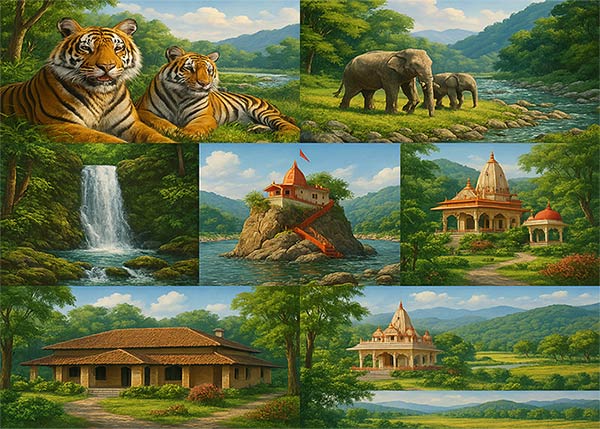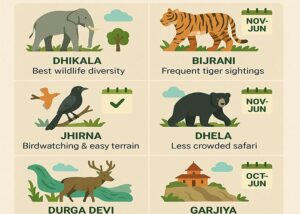If you’re planning a trip to Jim Corbett National Park, you might be wondering which places are worth visiting. Located at the base of the Himalayas, Jim Corbett is a great spot for nature lovers, wildlife fans, and adventure seekers.
It’s the oldest national park in India and home to the famous Bengal tiger. But there’s a lot more to see than just animals. Here are the top 10 places you should check out during your visit.
1. Dhikala Zone
The Dhikala Zone is the most famous and largest safari zone in Jim Corbett National Park. It’s often called the crown jewel of the park because of its stunning landscapes, rich wildlife, and deep connection to India’s conservation history
What Makes Dhikala Special?
- Wildlife Spotting: Dhikala is one of the best places to see Bengal tigers, wild elephants, deer, crocodiles, and hundreds of bird species.
- Scenic Beauty: The zone features wide grasslands, dense Sal forests, and the beautiful Ramganga River, which flows through the area.
- Dhikala Chaur: A large open grassland where you can often spot herds of elephants and deer grazing peacefully.
- Thandi Sadak & Kamarpatta: Quiet forest roads perfect for spotting wildlife and enjoying the calm beauty of nature.
- Mota Saal: A landmark area with tall Sal trees and frequent elephant sightings.
Stay Inside the Forest
One of the unique things about Dhikala is that you can stay inside the forest at the Dhikala Forest Rest House. Waking up to the sounds of birds and animals is a magical experience. Staying here also gives you early access to safaris and better chances of spotting wildlife
Rich Plant Life
Dhikala is full of important plant species like:
- Sal trees – forming dense forests.
- Khair and Sissoo – found near rivers.
- Bamboo and Elephant Grass – providing food and shelter for animals.
These plants help maintain the balance of the ecosystem and support both herbivores and predators.
Best Time to Visit
The best time to visit Dhikala is from November to June. The park is closed during the monsoon season (July to October) for safety and conservation reasons
Who Should Visit?
Dhikala is perfect for:
- Wildlife lovers
- Nature photographers
- Families looking for adventure
- Anyone who wants a peaceful escape into nature
2. Bijrani Zone
The Bijrani Zone is one of the most popular safari zones in Jim Corbett, especially for those hoping to spot a tiger. Located near Ramnagar, it’s easily accessible and offers a rich mix of wildlife, scenic beauty, and adventure
What You’ll See
- Bengal Tigers & Leopards: Bijrani is known for frequent tiger sightings, making it a favorite among wildlife photographers.
- Elephants & Deer: You’ll also spot wild elephants, Chital (spotted deer), Sambar, and Hog Deer.
- Birds: With over 600 bird species, it’s a paradise for birdwatchers, especially during the migratory season
Landscape & Terrain
- Grasslands (Chaurs): Wide open spaces where animals graze and roam freely.
- Dense Sal Forests: Tall trees and thick greenery that provide shelter to many species.
- Waterholes & Streams: Ideal spots for animals to gather, especially in the dry season.
Entry & Safari Info
- Entry Gate: Bijrani is accessed through the Aamdanda Gate, just 1 km from Ramnagar.
- Safari Options: Jeep safaris are available in the morning and evening. Elephant safaris are also offered here, but they’re limited and booked on a first-come, first-served basis
Permit & Booking: You need an entry permit, which can be booked online up to 45 days in advance or on the same day at the forest office.
Stay Options
There are two forest rest houses inside the zone:
- Bijrani Forest Rest House
- Malani Forest Rest House
These offer a chance to stay overnight in the jungle, but only for those with advance bookings. Day safari visitors cannot stay overnight.
Best Time to Visit
The best time to visit Bijrani is from November to June. The zone is closed during the monsoon season (July to October).
3. Dhangarhi Museum
Located near the Dhangarhi Gate, just 18 km from Ramnagar, the Dhangarhi Museum is one of the first places visitors encounter when entering Jim Corbett National Park. It’s not just a museum it’s a window into the park’s rich history, wildlife, and conservation efforts.
What You’ll See Inside
- Wildlife Exhibits: The museum displays preserved animals like tigers, elephants, leopards, and crocodiles. You’ll also find skulls, bones, and taxidermy models that give a close-up look at the park’s wildlife
- Jim Corbett’s Story: Learn about the legendary hunter-turned-conservationist, Jim Corbett. The museum showcases his personal items, photographs, and weapons, telling the story of how he helped protect India’s wildlife
- Park’s History & Ecology: Discover how the park was formed, its geography, and the different zones. Maps and models explain the diverse landscapes—from forests to rivers and grasslands
- Conservation Efforts: The museum highlights the park’s role in Project Tiger and other conservation programs aimed at saving endangered species
- Photo Gallery: Beautiful pictures of animals and scenic views of the park are displayed throughout the museum, making it both educational and visually engaging.
Souvenir Shop
There’s a small shop inside the museum where you can buy:
- Wildlife-themed books
- Corbett t-shirts and caps
- Handicrafts and wood-carved items
- Safari memorabilia
Location & Timings
- Location: Adjacent to Dhangarhi Gate, 18 km from Ramnagar
- Timings: Usually open from 9 AM to 5 PM, but may vary seasonally
- Entry Fee: Around ₹100 per person
Why Visit?
Visiting the Dhangarhi Museum before your safari helps you understand the park’s importance, its wildlife, and the efforts to protect it. It’s especially great for first-time visitors and families with kids.
4. Garjiya Devi Temple
The Garjiya Devi Temple is a famous Hindu shrine located in Garjiya village, about 13–14 km from Ramnagar, on the outskirts of Jim Corbett National Park. It’s dedicated to Goddess Garjiya, believed to be an incarnation of Goddess Parvati .
Unique Location
- The temple is perched on a large rock in the middle of the Kosi River, making it one of the most picturesque temples in Uttarakhand.
- Visitors reach the temple by crossing a suspension bridge over the river, adding to the adventure and charm of the visit
Spiritual Significance
- Garjiya Devi is worshipped as a Shakti deity, and the temple is considered a powerful place for blessings, protection, and prosperity.
- Inside the temple, there’s also a 9th-century black granite idol of Lakshmi-Narayan, adding historical depth to its spiritual importance
Festivals & Celebrations
- The temple is especially crowded during Kartik Poornima (usually in November or December), when thousands of devotees gather for prayers and rituals.
- During this time, the temple is beautifully decorated with lights, diyas, and flowers, creating a vibrant and festive atmosphere.
Scenic Beauty
- Surrounded by lush greenery, hills, and the flowing Kosi River, the temple offers stunning views and a peaceful environment.
- Many visitors also take a dip in the river near the temple, which is considered spiritually cleansing.
Best Time to Visit
- October to May is ideal, as the weather is pleasant and it aligns with the safari season in Jim Corbett.
- Avoid the monsoon season due to high river levels and limited access.
5. Kosi River: Nature’s Lifeline near Corbett
The Kosi River is a perennial Himalayan river that flows alongside the eastern boundary of Jim Corbett National Park, though it doesn’t enter the park itself. It originates from Dharpani Dhar in the Almora district and travels through Ramnagar and Dhikuli, eventually joining the Ramganga River.
Importance to Wildlife
- Even though the river doesn’t flow inside the park, it’s a crucial water source for animals like elephants, deer, and tigers, especially during dry seasons.
- The river supports a rich ecosystem, attracting migratory birds and providing water to nearby forests and farmlands
Activities around the River
- Angling: The river is home to Mahseer fish, making it a popular spot for fishing.
- Birdwatching: Many migratory birds visit the riverbanks, offering great opportunities for bird lovers.
- River Rafting: During the monsoon season, white-water rafting is possible in certain stretches, offering thrilling experiences for adventure seekers
Scenic Beauty
- The riverbed is filled with smooth boulders, and its flow is often erratic and unpredictable, especially during monsoons.
- Visitors love to sit by the river, dip their feet in the cool water, and enjoy the peaceful sound of flowing water.
- The river adds to the charm of nearby attractions like Garjiya Devi Temple, Dhikuli, and Ramnagar.
Safety Tips
- Avoid visiting during heavy monsoons, as the river can flood and become dangerous.
- Always follow local guidelines if you plan to engage in water activities.
- Respect the natural habitat—avoid littering and disturbing wildlife
Best Time to Visit
- October to June is ideal for visiting the Kosi River, especially if you want to enjoy its calm beauty and wildlife sightings.
- Monsoon months (July to September) are risky due to flooding.
6. Corbett Falls: A Peaceful Escape into Nature
Corbett WaterFalls is a beautiful waterfall located about 25 km from Ramnagar and around 25 km from Nainital, in the Kaladhungi area of Uttarakhand. It’s named after Jim Corbett, the legendary hunter and conservationist who spent much of his life in this region
What Makes It Special?
- Height: The waterfall drops from a height of about 66 feet (20 meters), creating a misty spray and a soothing sound that fills the forest.
- Surroundings: It’s nestled in a dense teakwood forest, offering a tranquil and refreshing atmosphere far from city noise
- Birdwatching: The area is rich in birdlife, making it a great spot for nature lovers and photographers.
- Picnic Spot: Forest authorities have developed the area for picnics, hiking, and camping, while keeping its natural charm intact
How to Reach
- By Road: Easily accessible by car or taxi. The falls are just 1.5 km from the parking area, followed by a short forest walk.
- Nearest Railway Station: Kathgodam, about 35 km away.
- Nearest Towns: Ramnagar and Nainital.
Best Time to Visit
- Monsoon Season (July to September): The waterfall is at its most powerful and the forest is lush green. However, be cautious as the paths can be slippery
- October to June: Ideal for hiking, photography, and peaceful picnics.
Visitor Tips
- Wear comfortable shoes for the forest walk.
- Avoid visiting during heavy rains due to slippery rocks.
- Carry water and snacks, but don’t litter help keep the forest clean.
7. Corbett Museum: A Tribute to Jim Corbett’s Legacy
Located in Kaladhungi, about 30 km from Ramnagar, the Corbett Museum is housed in the heritage bungalow of Edward James “Jim” Corbett, the legendary hunter-turned-conservationist. This museum offers a deep dive into his life, work, and the history of wildlife conservation in India
What You’ll Discover
Jim Corbett’s Personal Belongings
- His gun, cap, satchel, letters, and manuscripts
- Photographs from his hunting days and conservation work
- Sketches and paintings created by Corbett himself
His Work & Talents
- Corbett was not just a hunter he was also a writer, painter, carpenter, and photographer
- The museum showcases his books, handmade furniture, and artwork, giving insight into his multifaceted personality
Conservation History
- Learn about Corbett’s role in establishing India’s first national park
- Discover his efforts in Project Tiger and his influence on wildlife protection
- See how he helped local villagers and supported community development
The Museum Setting
- The museum is set in Choti Haldwani, a village Corbett once owned and later gifted to locals after India’s independence
- The bungalow is surrounded by lush gardens, large trees, and a peaceful atmosphere, perfect for a relaxing stroll
Souvenirs & Learning
- A small shop offers handicrafts, books, and wildlife-themed souvenirs
- An information center provides maps and guides for exploring the Corbett Tiger Reserve responsibly
Best Time to Visit
- Open year-round, but best visited October to June when the weather is pleasant
- Ideal for families, students, and anyone interested in history or nature
8. Shri Hanuman Dham
Located in Choi, Ramnagar, just a short drive from Jim Corbett National Park, Shri Hanuman Dham is a beautiful and serene temple dedicated to Lord Hanuman. It’s not just a religious site it’s a place for peace, reflection, and community support
Location & Atmosphere
- Surrounded by lush green lawns, water bodies, and fountains, the temple offers a calm and refreshing environment.
- The area is ideal for visitors looking to relax after a safari or spend quiet time in nature
Temple Architecture
- The temple features a grand arched gateway with carvings of two fishes, symbolizing fortune and prosperity.
- The structure has a chhatri-style design with ornate columns and a majestic central shrine dedicated to Lord Hanuman
- Both the interiors and exteriors are beautifully crafted, making it a visual delight for architecture lovers.
Facilities & Features
- Meditation Hall: A peaceful space for introspection and spiritual practice.
- Seating Area: Comfortable spots for visitors to rest and enjoy the surroundings.
- Center for the Disabled: A thoughtful addition that makes the temple inclusive and welcoming to all.
- Community Services: The temple often hosts spiritual and social events, contributing to the local community.
Best Time to Visit
- Open year-round, but best visited October to March when the weather is pleasant.
- Early mornings and evenings are ideal for meditation and enjoying the peaceful ambiance.
9. Sitavani Temple
Located in the Sitavani Safari Zone, about 24 km from Ramnagar, Sitavani Temple is a sacred site dedicated to Goddess Sita, the wife of Lord Rama. It’s believed to be the place where Sita stayed during her exile, making it a spiritually significant destination for pilgrims and mythology lovers,
A Temple in the Jungle
- The temple is surrounded by dense forests, chirping birds, and the peaceful sounds of nature.
- As you walk toward the temple, you’re greeted by the rustling of leaves, cool breezes, and a serene atmosphere that’s perfect for meditation and introspection
Mythological Significance
- According to legends, Sita lived in this forest during her exile and gave birth to her sons, Luv and Kush, here.
- The temple honors her strength, devotion, and connection to nature, making it a place of deep spiritual reflection
Wildlife around the Temple
- The Sitavani Safari Zone is known for its rich wildlife. Visitors often spot:
- Deer
- Elephants
- Leopards
- And occasionally, the Bengal tiger
- This makes a visit to the temple a unique mix of pilgrimage and safari adventure
Best Time to Visit
- November to June is ideal, with pleasant weather and better chances of wildlife sightings.
- The temple is open year-round, but avoid the monsoon season due to slippery paths and limited access.
Why Visit?
- A peaceful place for prayers and meditation
- A chance to explore mythology and wildlife together
- Ideal for families, spiritual seekers, and nature lovers.
10. Ramganga River
Last but not least, the Ramganga River is the main river flowing through Jim Corbett National Park, and it plays a vital role in sustaining the park’s rich biodiversity. Without this river, Corbett wouldn’t be the thriving wildlife haven it is today
Origin & Flow
- The river originates in the Doodhatoli ranges of the Lesser Himalayas, near Gairsain in Uttarakhand.
- It flows southwest for over 100 km, entering the park near Marchula, and travels about 40 km through the park before reaching Kalagarh dam, where it enters the plains
- Eventually, it joins the Ganga River near Farrukhabad in Uttar Pradesh.
Ecological Importance
- The Ramganga River is the largest and most important water source inside the park.
- It supports a wide variety of wildlife, including:
- Mahseer fish – popular among anglers
- Gharials – endangered fish-eating crocodiles
- Mugger crocodiles, otters, and turtles
- Birds like kingfishers, fish eagles, terns, and storks
During winter, the Ramganga reservoir attracts migratory birds from Europe and Central Asia, making it a hotspot for birdwatching.
Tributaries
The river is fed by several smaller rivers that enhance its flow and ecological value:
- Palain River
- Mandal River
- Sonanadi River – also the name of a wildlife sanctuary adjoining Corbett
Activities & Attractions
- Angling & Fishing: The river is famous for sport fishing, especially for the mighty Mahseer.
- Wildlife Viewing: Many safaris in the Dhikala Zone follow the river’s path, offering excellent chances to spot animals near water.
- Photography: The river’s scenic beauty, especially during sunrise and sunset, is a treat for photographers.
Best Time to Visit
- November to June is ideal for visiting the river inside the park.
- Monsoon months (July to September) are risky due to flooding and restricted access.
Conclusion –: A Journey into Nature and Heritage
Jim Corbett National Park is more than just a wildlife sanctuary it’s a vibrant blend of natural beauty, spiritual depth, and historical richness. From thrilling safaris in Dhikala and Bijrani, to peaceful moments at Garjiya Devi Temple and Shri Hanuman Dham, every corner of Corbett offers something unique.
Whether you’re soaking in the serenity of Corbett Falls, exploring the legacy at the Corbett Museum, or connecting with mythology at the Sitavani Temple, your journey here will be filled with unforgettable experiences.
Last but not least, the Ramganga River, flowing gracefully through the park, nourishes its diverse ecosystem and adds to the park’s timeless charm.
So pack your bags, charge your camera, and get ready to explore one of India’s most treasured natural wonders. Jim Corbett awaits with open arms and wild adventures.




